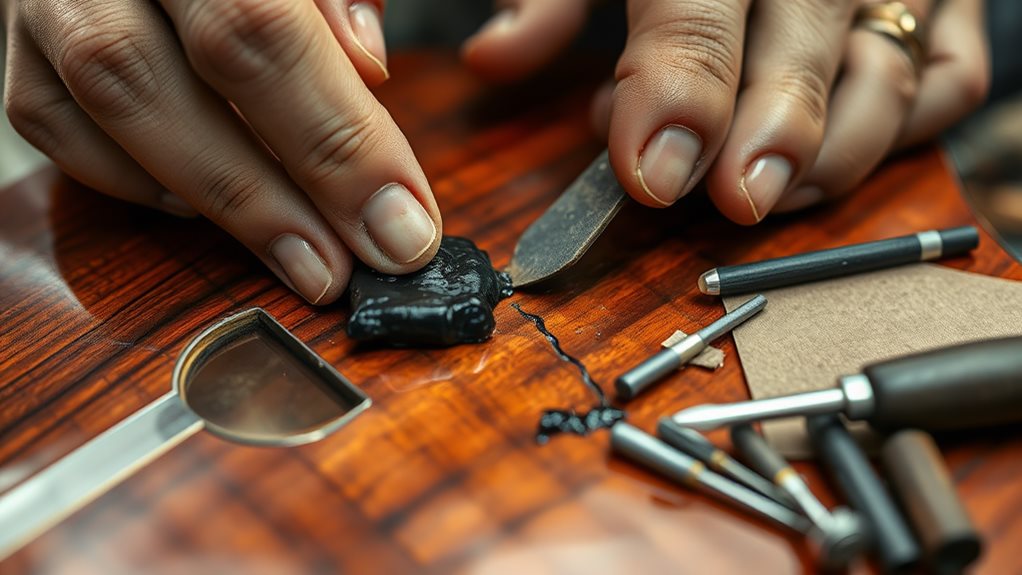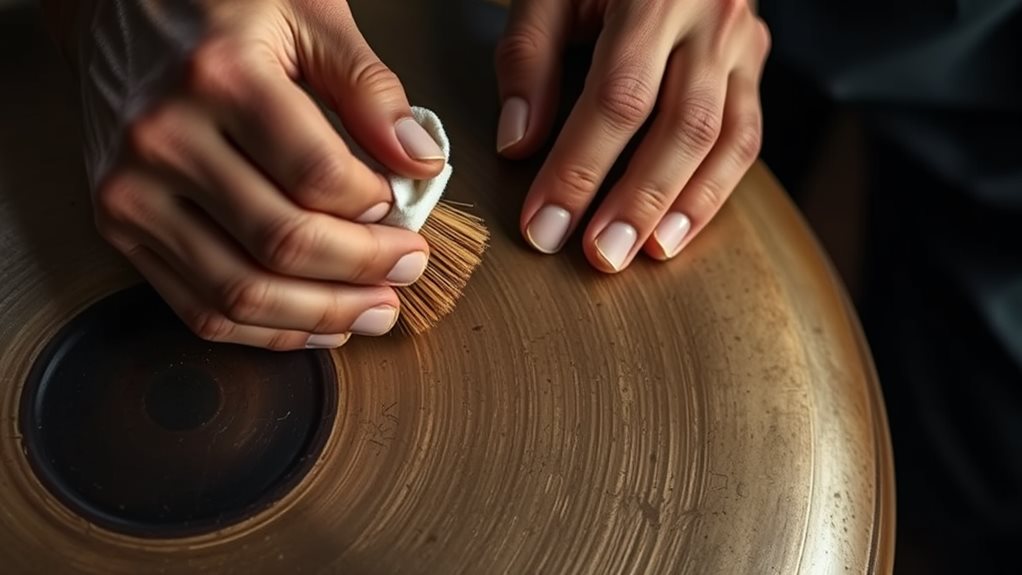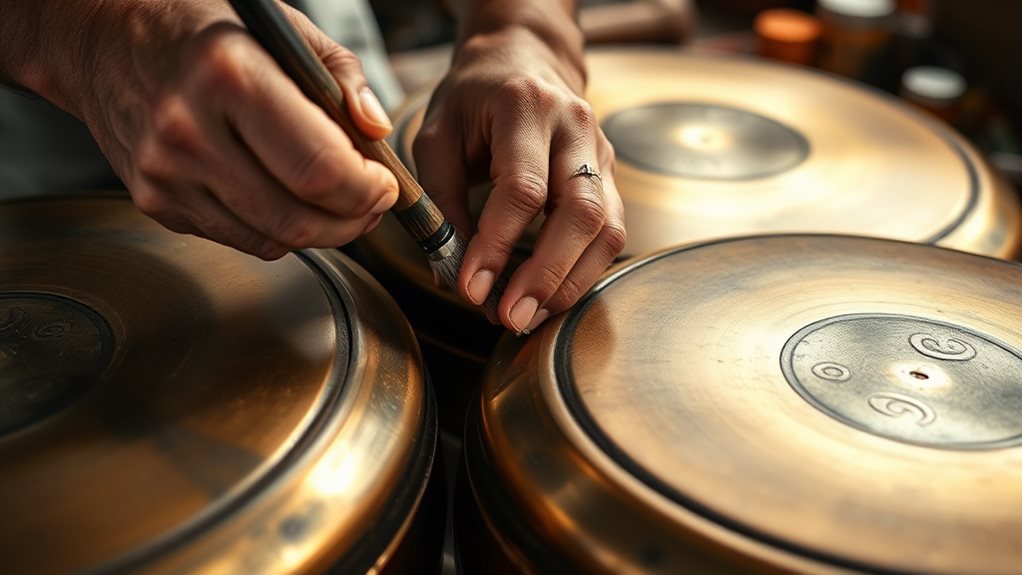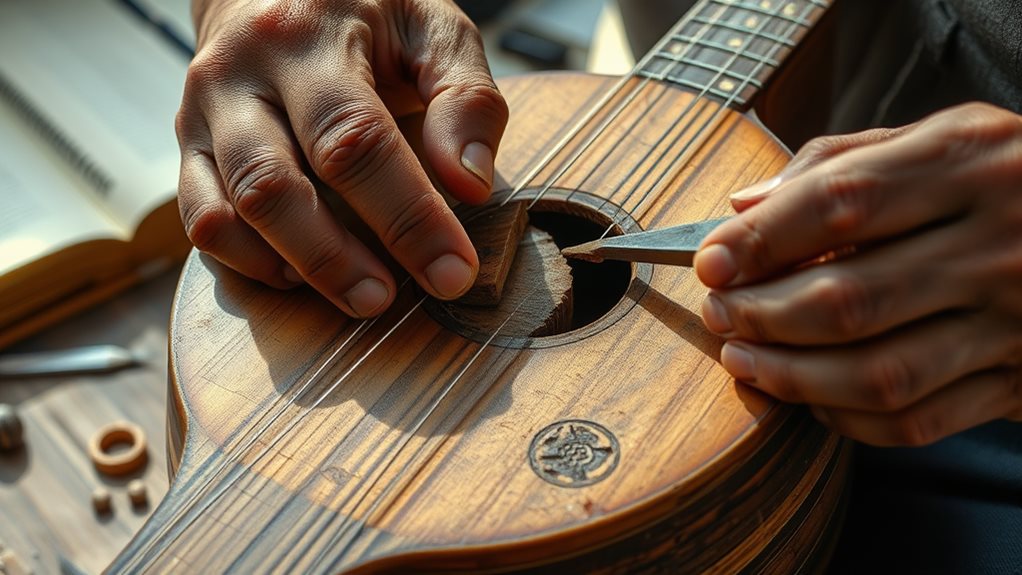Preserving Filipino Musical Instruments Requires Climate Control and Archival Materials****
To safeguard cultural heritage, it is essential to store Filipino musical instruments in a controlled environment with a stable temperature and humidity level. Archival materials, such as acid-free paper and boxes, prevent damage from moisture and pests. These materials also protect instruments from dust and scratches.
Gentle Cleaning Techniques Preserve Instrument Condition
Different materials require specific cleaning methods to avoid damage. For example, gentle brushing with a soft-bristled brush is effective for cleaning wooden instruments, while metal instruments require a soft cloth and mild soap. Cleaning instruments regularly prevents dirt and grime from building up and causing irreparable harm.
Documenting Instrument History and Sound Enhances Preservation
Meticulous documentation of an instrument's condition, history, and sound helps preserve its cultural significance**. Recordings of the instrument's sound and detailed descriptions of its materials and craftsmanship provide valuable information for future generations. Photographs and videos also help capture the instrument's appearance and playing techniques**.
Community Involvement and Government Support Ensure Long-term Preservation****
Collaboration between local communities, cultural institutions, and government agencies is crucial for the long-term preservation of Filipino musical instruments. Community involvement helps raise awareness about the importance of preserving cultural heritage, while government support provides necessary resources and funding. Government programs can also provide training and education on conservation techniques****.
Safeguarding Cultural Heritage through Careful Storage and Exploration
Careful storage in a stable environment is vital to preserving Filipino musical instruments**. Instruments should be stored in a secure location with minimal handling to prevent damage. Further exploration of conservation techniques and materials can also lead to more nuanced approaches to preserving cultural heritage**.
Essential Tools and Materials

A well-equipped conservation laboratory requires specific tools and materials to ensure the long-term preservation of valuable musical instruments.
A climate-controlled environment** is essential, which can be achieved with an air-conditioning unit**. This provides a stable environment for the instruments and prevents damage from temperature and humidity fluctuations.
Ample workspace is necessary, including a large table and chairs, to allow for efficient and comfortable work. Shelves and plastic storage boxes provide organized storage for archival materials and supplies, keeping them easily accessible and protected.
Soft brushes, an art gum eraser, gauze, blotting paper, and a heat iron are essential for handling and cleaning archival materials. These tools are used for delicate cleaning and surface treatment, ensuring the instruments aren't damaged during the conservation process.
pH strips are crucial for assessing the acidity of materials, allowing conservators to determine the best course of treatment. Polyester Melinex rolls are used for encapsulation, a vital restoration technique that protects fragile instruments from environmental damage.
Acid-free tapes, such as Filmoplast P, P90, and double-sided adhesive tapes, are used for repairs, along with acid-free folders, papers, and boards for safe storage.
Japanese tissue is often used in various restoration techniques, providing a gentle and non-abrasive material for delicate repairs.
Methyl cellulose strengthens weakened paper, while calcium carbonate and magnesium hydroxide**** neutralize acidity.
Archival mist offers a non-aqueous deacidification option, providing a gentle and effective way to remove acidity from materials.
Filmoplast archival tape mends tears, and encapsulation materials protect instruments from environmental damage.
Proper selection and use of these tools and materials are critical for effective and ethical restoration techniques.
The goal is to ensure the long-term preservation of these valuable musical instruments using appropriate archival materials and methods.
Initial Assessment and Recording
Initial Assessment: A Crucial Step in Preserving Filipino Musical Instruments****
To begin preserving Filipino musical instruments, you must conduct a thorough initial assessment. This involves evaluating each instrument's material state by noting wear, damage, and deterioration**. Identify the materials used, such as bamboo, wood, or metal**, and document everything meticulously.
Visual Documentation: A Key Component
High-resolution photography and videography are essential for visual documentation, capturing each instrument from multiple angles, even in use. This provides a comprehensive record of the instrument's condition.
Audio Recordings: Preserving Unique Sounds****
Audio recordings are necessary to preserve the unique sounds and playing techniques of each instrument. These recordings complement the visual documentation and provide a complete picture of the instrument's characteristics.
Detailed Written Descriptions: Capturing History and Significance
Detailed written descriptions are required to capture the history, construction, and playing methods of each instrument. These descriptions should include information on the instrument's cultural and historical importance.
Digital Archiving: Ensuring Long-Term Accessibility****
All documentation, including visual, audio, and written records, should be digitally archived to ensure long-term accessibility and preservation.
Instrument Valuation: Beyond Monetary Worth
Instrument valuation goes beyond monetary worth; it's about cultural relevance. Consider the cultural and historical importance of each instrument, prioritizing those with the highest significance for conservation efforts.
Collaboration and Community Involvement: Ensuring Accuracy and Comprehensiveness
Collaborate with experts, such as ethnographers and musicians, to ensure accuracy and comprehensiveness. Gather information from traditional players and community members, as their insights are invaluable.
Documenting Condition and Usage Patterns
Document detailed condition reports, noting any damage or deterioration. For instruments with paper or fabric components, test pH levels. Record usage patterns to understand wear and tear.
Identifying Conservation Needs and Prioritization
Based on the assessment, identify specific conservation needs and prioritize instruments accordingly. This initial assessment forms the foundation for effective and culturally sensitive conservation efforts, guiding future decisions.
Cleaning and Repair Methods

Cleaning Methods
The choice of cleaning method depends on the material of the instrument. Aqueous cleaning is effective for water-resistant woods and metals, while non-aqueous methods are used for delicate materials like paper.
To remove dust, soft brushes are used. Infrared and ultraviolet photography can help locate faded inscriptions, allowing for targeted cleaning. Additionally, microfuming can eliminate pests.
Repair Techniques
To repair instruments, various techniques are employed. Tears can be mended with archival tape or Japanese tissue, while methyl cellulose paste can strengthen paper.
Fragile items can be encapsulated in polyester film. Traditional wood and metalworking skills are essential for structural repairs. Original finishes can be matched using retouching techniques and color theory.
Modern Innovations and Safety
Modern innovations, such as UV fluorescence imaging, can aid in the restoration process. Synthetic adhesives can be used for protection, and acid-free materials can prevent further damage.
It's crucial to prioritize shop safety and proper tool maintenance. When restoring instruments, historic varnish formulas can be considered for authenticity.
Stabilization and Support
Instrument Stabilization and Support
Handle Instruments with Care
Instrument stabilization and support are crucial for long-term preservation. Avoid shocks and excessive string tension to maintain structural integrity. For heavy instruments, use dollies to distribute weight evenly during movement.
Controlled Climate
Maintain a stable 68°F (20°C) temperature and controlled humidity levels to prevent warping and cracking. Utilize RH-controlled storage to create a stable environment, shielding instruments from direct sunlight and temperature extremes.
Minimize Handling
Minimize handling, especially for frequently played instruments, to prevent wear and tear.
Functional Assessment
Before any intervention, a thorough functional assessment is needed. Examine the instrument's structure for deterioration, such as cracks or loose joints.
Reinforce Weak Points
Reinforce weak points using compatible materials that won't affect the instrument's sound or function. Ensure supports don't create undue pressure.
Regular Reassessment
Regularly reassess and update support methods to align with best practices. Balance the desire to restore playability with the potential for further wear.
Prioritize Preservation
Decide whether an instrument can be safely played without causing further damage; document its condition before and after any action.
Prioritize long-term preservation goals, using analytical tools to understand the instrument's original construction.
Protecting the Instruments

Protecting Instruments: A Multifaceted Approach
Protecting instruments involves a combination of careful handling, appropriate storage, and strategic conservation materials and techniques. This approach includes using traditional methods alongside modern synthetic adhesives and coatings, and working with various materials like wood, metal, textiles, and leather. Understanding the cultural significance of each instrument guides conservation choices.
Conservation Materials and Techniques
Conservators use archival supplies like acid-free tapes and Japanese tissue to mend tears and strengthen paper.
Polyester Melinex is used for encapsulation of delicate components.
Cleaning methods vary depending on the material, with options including aqueous or non-aqueous approaches, dry cleaning for certain markings, and microfumigation to remove pests.
Deacidification methods, such as archival mist, protect against further deterioration.
Restoration and Documentation****
Restoration involves digital imaging for documentation and evaluation.
Historic varnish formulas and color theory are used for retouching, aided by ultraviolet fluorescence and infrared photography.
Detailed record-keeping is crucial, including material analysis and measurements.
This documentation preserves knowledge for future generations and highlights the cultural significance of each artifact.
Authentication and Preservation
Instruments are authenticated using techniques like historical metrology and dendrochronology.
Recording the wisdom of elder musicians helps safeguard traditional knowledge.
Accurate measurement techniques and conservation reports preserve the integrity of these valuable instruments and their historical context.
Cultural significance is carefully considered in every step of the process.
Storage and Environmental Controls
Proper Storage and Environmental Controls are Essential
Proper storage and environmental controls are crucial for the long-term preservation of cultural artifacts.
Climate-controlled cases with pre-conditioned silica gel ensure optimal humidity and temperature stability.
Acid-free materials should be used for all storage solutions, including boxes, folders, and papers, to prevent chemical degradation.
Secure Storage Areas Protect Instruments
Instruments should be stored in secure areas to prevent damage and unauthorized access.
Customized storage solutions, such as hard cases for stringed instruments and soft cases for wind instruments, should be employed.
Humidity Control is Paramount
Maintaining a stable temperature between 18-22°C prevents warping or cracking.
Humidity levels should ideally remain between 40-60% to avoid moisture damage or dryness.
Anoxic disinfestation methods should be used to control pests, minimizing harm to the instruments.
Additional Environmental Controls
Minimize exposure to direct sunlight and UV radiation to prevent material degradation.
Monitor air quality and prevent pollution and dust buildup.
Handle instruments with gloves to avoid damaging surfaces with skin oils.
Regular Monitoring and Maintenance
Regularly inspect and maintain storage facilities to ensure the longevity of cultural artifacts.
Schedule maintenance checks and use ultraviolet fluorescence and infrared photography to detect hidden damage.
Keep detailed records of all conservation treatments****.
Community-Based Preservation

Community-Based Preservation Ensures Cultural Identity****
Proper storage is essential, but it's community involvement that truly safeguards traditional instruments. Active participation in cultural festivals**** showcases instruments like the kulintang, kudyapi, and gimbal, highlighting their cultural significance for younger generations.
Community workshops offer hands-on learning opportunities, transmitting knowledge of construction, repair, and playing techniques. These workshops are vital for maintaining the cultural context surrounding these instruments, going beyond skill development to preserve cultural heritage.
Indigenous communities have historically passed down knowledge across generations, ensuring the continuity of musical traditions. Intergenerational transmission is invaluable, as seen in regular displays of instruments at community events, such as weddings or funerals, which familiarize children with their heritage.
Local performances, featuring artists like Nonoy Lanzanas and his Sinika group using tribal instruments, play a significant role in promoting and preserving cultural heritage.
Community-based preservation isn't simply about safeguarding objects; it's about safeguarding cultural identity, ensuring that the sounds of these instruments continue to resonate through future generations.
These instruments aren't mere artifacts; they're living expressions of cultural heritage, their survival dependent on active community engagement.
Collaboration and Partnerships
Collaboration is essential for the conservation of Filipino musical instruments. Effective conservation requires a multi-pronged approach involving diverse collaborations and partnerships. For instance, universities like the UP College of Music collaborate with faculty and students to preserve music scores and instruments using interdisciplinary approaches.
Universities play a crucial role in conservation. Simple conservation labs can be established within universities, involving conservation specialists and students in restoration. Decision tables guide treatment decisions, ensuring the best possible outcomes.
Government support is vital, as mandated by the Philippine Creative Industry Law (PCIL) and funded by the National Research Council of the Philippines (NRCP). This support fuels research, develops policies, and fosters collaborations between universities and government agencies to protect cultural significance.
Community and cultural institutions are also key partners. Collaborations with ethnic groups involve local communities in preservation and performance, passing down traditional knowledge.
Events like the Asean Cultural Fair showcase the fruits of these collaborations, promoting Filipino traditional music internationally.
International collaborations are essential, allowing for the exchange of knowledge and practices between different cultural and academic institutions. This strengthens the overall effort to preserve Filipino musical instruments and their cultural significance.
Research and Documentation

Comprehensive research and documentation are essential for understanding the significance of historical instruments**. To achieve this, researchers meticulously record each instrument's origin, age, and historical context, including the materials** used in its construction.
Dating instruments involves using historical metrology and dendrochronology****. Historical metrology helps determine the instrument's age by analyzing measurements and units used during its construction. Dendrochronology, on the other hand, involves studying tree rings to date wooden instruments.
Detailed assessment of the instrument's physical condition is crucial. Researchers identify areas needing conservation or restoration by evaluating wear and tear, noting materials requiring specific treatments like cleaning, varnishing, or repair.
Advanced techniques help uncover hidden details****. Ultraviolet fluorescence and infrared photography can reveal faded inscriptions, while precise measurements help understand the instrument's original state.
Conservation techniques are carefully documented. Researchers detail the application of adhesives and coatings, cleaning procedures for different materials, and methods for paper preservation.
This documentation is essential for preserving indigenous knowledge****.
Creating archives and databases ensures accessibility for researchers and the public. Comprehensive reports and studies illuminate the historical context and cultural significance of these instruments, informing policy development and implementation.
Future of Conservation Efforts
The future of Filipino musical instrument conservation relies on a multi-faceted approach that combines government support, community empowerment, technological advancements, and sustainable cultural exchange.
Government Support: Strong government policies, such as those under the Philippine Cultural and Intangible Heritage Law (PCIL), are essential to provide funding and legal frameworks that protect ancestral domains and traditional knowledge.
For instance, the PCIL supports the preservation of cultural heritage sites and intangible cultural practices, including traditional music and instruments.
Community Empowerment: Community participation is crucial in ensuring cultural sustainability. Local communities should be involved in research, workshops, and performances to promote ownership and cultural pride.
For example, community-based archiving initiatives can empower local communities to take charge of preserving their cultural heritage.
Technological Advancements: Digital preservation plays a vital role in conserving Filipino musical heritage.
Video recording and digital archiving can document traditional techniques and music, making it easier to access and disseminate. Additionally, 3D scanning can be used for replication, allowing for the preservation of fragile instruments.
Sustainable Cultural Exchange: Sustainable cultural exchange is essential to balance tradition with modern demands.
Collaborations and cross-cultural learning can promote the sharing of knowledge and increase global appreciation, while maintaining cultural authenticity. For instance, cultural exchange programs with international institutions can facilitate the sharing of knowledge and skills between Filipino musicians and their international counterparts.
This integrated strategy ensures the long-term preservation of Filipino musical heritage by promoting cultural sustainability through digital preservation, empowering communities, and bolstering government support.
Questions and Answers
What Ethical Considerations Guide the Process?
Cultural Significance and Community Involvement: When working with cultural artifacts, it is essential to consider their cultural significance and involve the community in the preservation process. This means understanding the importance of the artifact to the community and involving community members in decision-making processes.
Respect for Original Materials: Preserve the original materials as much as possible. This approach ensures that the artifact remains in its original state, with minimal alterations or interventions. This is crucial in maintaining the artifact's authenticity and cultural significance.
Minimal Intervention: Intervene only when necessary, and always prioritize minimal intervention. This means that any actions taken to preserve the artifact should be minimal and reversible, ensuring that the artifact's original state is maintained.
Documentation: Document every action taken during the preservation process. This includes recording any interventions, materials used, and steps taken to preserve the artifact. This documentation is essential in maintaining transparency and accountability.
Reversibility: Prioritize reversibility in all preservation actions. This means that any actions taken should be reversible, allowing the artifact to be returned to its original state if necessary. This approach ensures that the artifact's authenticity is maintained, and any changes can be easily reversed.
Authenticity: Prioritize authenticity in all preservation actions. This means that the artifact should be presented in its original state, without any significant alterations or interventions. This approach ensures that the artifact remains true to its cultural significance and historical context.
How Are Instrument Values Assessed?
Instrument values are determined through appraisal methods, which consider various factors. These factors include historical significance, such as the instrument's role in a significant musical event or its association with a famous musician. Materials used to craft the instrument, like rare or high-quality woods, also contribute to its value. Additionally, the cultural context in which the instrument was created or used, such as its importance in a particular genre or tradition, is assessed. Finally, authenticity, or the instrument's provenance and accuracy to its original design, is verified to ensure its value.
What About Intangible Heritage Aspects?
Intangible Heritage Aspects
When considering cultural heritage, it's essential to examine the intangible aspects that are deeply rooted in traditional practices. Cultural memory is embedded in these practices, which are often passed down through generations. For instance, traditional songs may tell stories that have been preserved through oral tradition, conveying historical events, myths, or legends.
Rituals surrounding instrument use are also an integral part of intangible heritage. In some cultures, instruments are considered sacred and are only played during specific ceremonies or events. Additionally, knowledge transfer methods, such as apprenticeships or mentorship, play a significant role in preserving traditional practices. These methods allow experienced practitioners to share their skills and knowledge with the next generation, ensuring the continuation of cultural heritage.
How Is Funding Secured for Projects?
Funding is secured through various channels. These include grant applications, crowdfunding strategies, and corporate sponsorships. Grant applications involve submitting proposals to organizations that provide funding for specific projects, such as government agencies or foundations. Crowdfunding strategies rely on online platforms to raise small amounts of money from a large number of people, often in exchange for rewards or incentives. Corporate sponsorships occur when companies provide funding in exchange for brand visibility, product promotion, or other benefits. Additionally, community involvement can boost resources by engaging local volunteers, donors, or partners who can contribute time, expertise, or funding to the project.
Who Owns the Conserved Instruments?
Ownership of Conserved Instruments Varies
Ownership of conserved instruments is not uniform and can be attributed to different entities. Communities, institutions, or both can own these instruments, depending on the specific instrument and its cultural significance.
For instance, a traditional instrument like a Native American flute might be owned by the community that created it, as it holds significant cultural value. On the other hand, a rare, historical instrument like Stradivarius violin might be owned by a museum or institution, which is responsible for its preservation and display.
Ultimately, the ownership of conserved instruments depends on the specific circumstances surrounding each instrument.